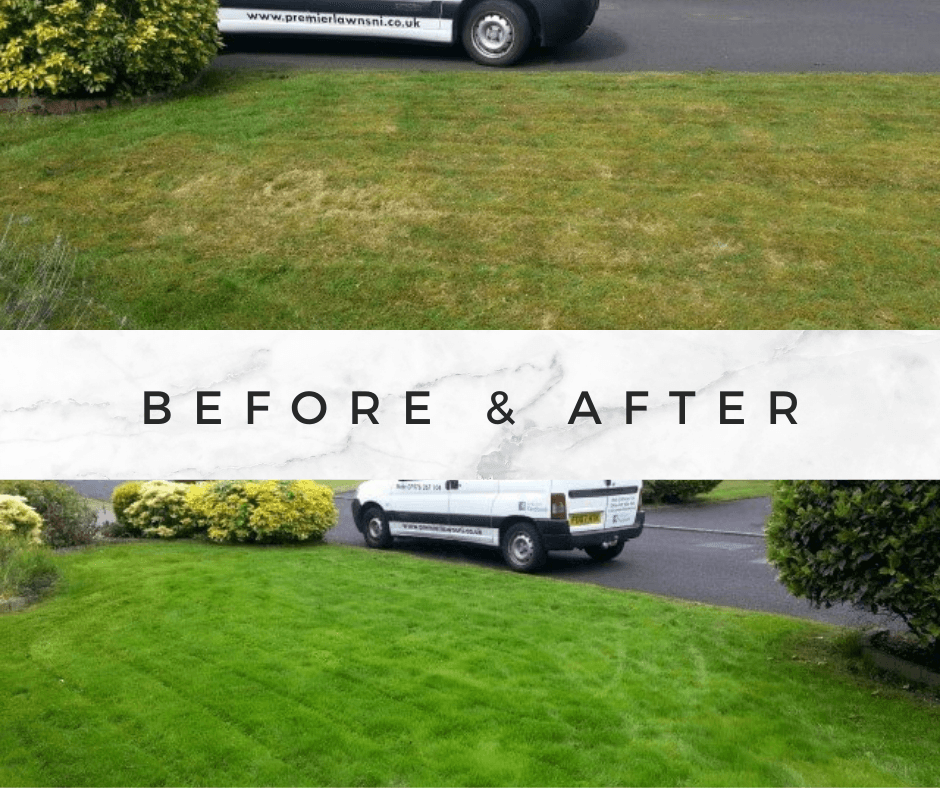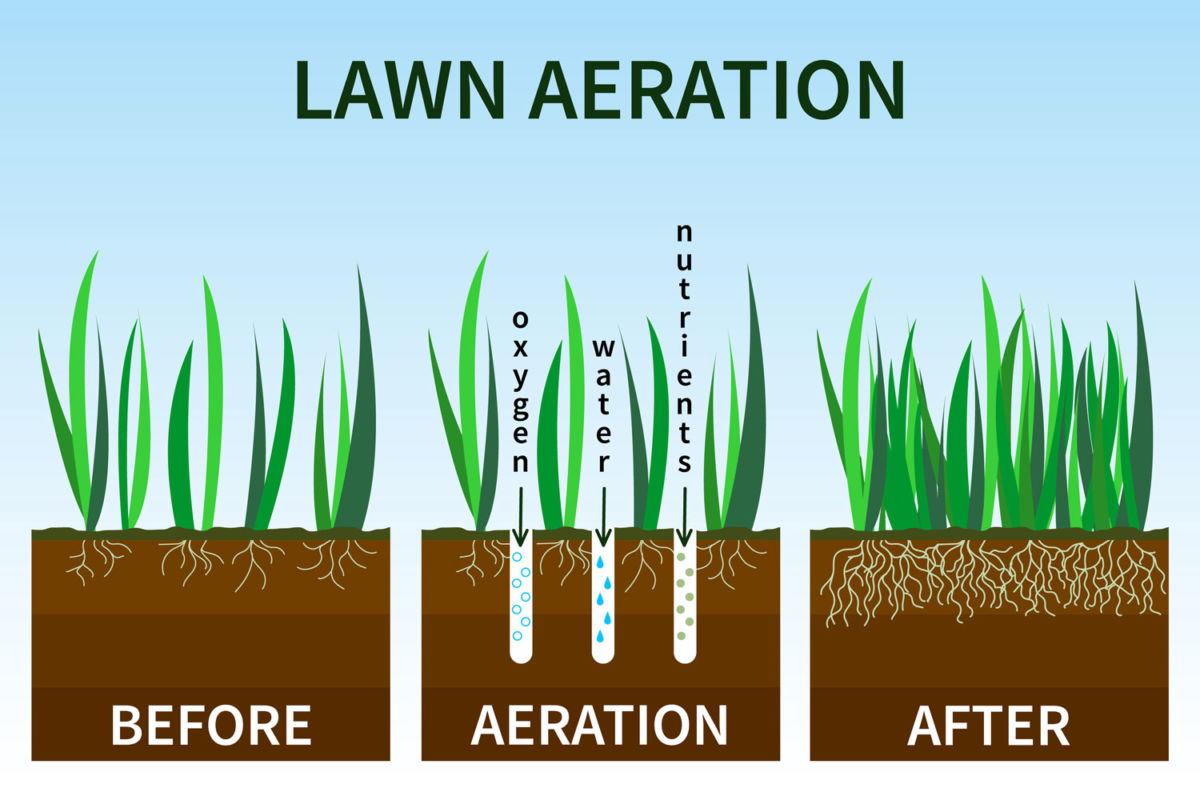Unhappy with your lawn but don’t know how to fix it? Here is our beginners guide to renovating an ugly lawn.
The number one thing to remember when renovating an ugly lawn, is that you won’t be able to fix it in a day. So be patient with yourself, take it one step at a time and don’t get overwhelmed. In this article, I’m going to give you some bite sized chunks of advice. Follow them carefully and in the right order, and in 6 months from now, you’ll be feeling a lot better about your lawn.
- Don’t panic
- Make a photo record of your lawn before you start work
- Do your research and get expert advice
- Be methodical and don’t rush
- Expect your lawn to look worse before it looks better
- Work with the weather – not with the calendar
- Start at the bottom and work upwards, improving the soil structure first, then getting rid of moss and thatch and finally working on the sward.

The same lawn before renovation and one month after treatments from Premier Lawns
First Things First – Gather Information And Prepare A Plan
Rushing headlong into a project never gets the desired results. Whether you are preparing an incredible meal, booking the holiday of a lifetime or starting a business, it’s important to have a plan and be prepared.
For any lawn renovation, I always recommend starting off with photos and videos of your lawn. They’re really useful if you need to get expert advice. And, you’ll be able to record your progress as you go along. Mother Nature works subtly sometimes, and that can make you feel as though your work has been in vain. Looking back at pictures will help you prove to yourself that you’ve made a difference.
I’m sure you already know what you don’t like about your lawn. So now you need to know how to fix it. List the problems that you think you have, and then scoot over to the Premier Lawns YouTube channel to discover how to tackle them. We have videos on just about every aspect of lawn renovation, from how to remove moss to how to level up a lumpy lawn, kill weed grasses or cope with dog urine scorch. I’ll post some links at the bottom of the page to help you.
It’s also worth joining the Premier Lawns Community on Facebook. We have over 2,300 members who are all at different stages of their lawn care journey. There are learners like yourself who have lots of questions, and there are lawn care experts who are always willing to share their experiences without judging or belittling anyone. It’s a nice place to be.
Managing Your Expectations
When you are renovating an ugly lawn, remember that it may have taken several years to accumulate all of that moss as well as those bare patches and weeds. Don’t think that you can fix it overnight. Premier Lawns has been renovating ugly lawns for over 20 years, and with each and every one of them, patience has been a key part of our success.
Things will look worse before they get better. As my Granny used to say – you have to make a mess to clear one up. That’s normal and it’s nothing to worry about.
Grass grows when the weather says it must – not when the calendar says it should. So if you read an article that suggests you should scarify in march – but there’s snow on the ground – keep off the lawn until the conditions are right. Trying to renovate an ugly lawn if the soil is cold or sodden is like wearing a concrete life jacket to go swimming – counter productive!
Ready to Start?
At Premier Lawns, when we’re renovating an ugly lawn, we’ll always start at the bottom and work upwards. What does that mean? Well, there are 3 layers in your lawn. The soil, the thatch and the foliage.
If you dig a small section out of your lawn you’ll be able to clearly see the three layers. In a happy lawn, you should be able to see lots of healthy roots in amongst the soil layer. Roots that go down for a good 15cm or more and have lots of fibrous branches to them. However, if your lawn is mossy, bare or weak, the chances are that the soil is bereft of roots.
The actual grass foliage is the bit that you see and the bit that you want to look lovely. However the foliage depends largely on the plants’ roots being able to reach deep into the soil to suck up the water and nutrients needed to keep those grass blades looking plump, green and healthy.
So our first job is going to be aerating to improve the soil structure and make it easier for the roots to thrive.
Aeration For Beginners
Aeration is a technique that greenskeepers and lawn lovers from all over the world use to open up the soil structure beneath a lawn. When you are gardening for flowers of vegetables, you tend to a) avoid compacting the soil by walking on it, and b) hoe, dig or rotate every so often to loosen up the soil structure.
Now, it’s not really possible to dig the soil beneath your lawn, so aeration is the best alternative. It’s as simple as making holes all over the lawn. At Premier Lawns we use a mechanical hollow tined aerator to remove little plugs of soil. But you could also use a manual aerator, or, if you want to confuse your neighbours, a drill.

Removing those plugs of soil opens up the structure so that water and nutrients can filter down deep into the soil. It also creates room for the roots to grow. When soil is compacted – especially clay soils – there are not enough gaps between particles for the roots to push into. In turn, this restricts the plants’ ability to grow to its full potential.
Scarifying For Beginners
The next layer in your lawn is the thatch. If you look at a cross section of your lawn, it’s the straw coloured bit between the soil and the green grass.
Thatch is an accumulation of dead and dying grass leaves, moss and other debris. This is where and weed seeds get lodged, where fungal diseases thrive. A really thick thatch layer also makes the lawn feel spongy to walk on, and it can actually slow down the absorption of water and fertilisers.
Scarifying pulls moss and thatch out of the lawn and gives the grass plants more room to grow. It’s a bit like decluttering your child’s bedroom….it makes it easier for them to find life’s little essentials.
You can use a spring tine rake to scarify a tiny lawn, but it will take a lot of time and energy to tackle most lawns. I recommend hiring a mechanical scarifier or asking a lawn care professional to do the work for you.
Don’t forget to get rid of the waste —- there’ll probably be more of it than you could have imagined.
Renovating An Ugly Lawn – Levelling Up
By the time you’ve finished aerating and scarifying, your lawn is going to look very different. If you feel it’s a bit too lumpy and bumpy for your liking, you can topdress it to fill the dips and level it up.
Now is also the time to overseed any bare patches.
Lawn Feeding For Beginners
Once your lawn has been aerated, scarified and levelled it’s probably going to look a bit sorry for itself. Don’t panic. This is only temporary. To help it recover, you need to start a regular regime of feeding and applying treatments.
Choose a good quality lawn feed that’s right for the time of year. At the time of writing, fertilisers have seen a massive price rise, but please don’t let that put you off. You’ve already done so much work, don’t let it go to waste for the sake of a few quid. The Premier Lawns Community Facebook Group will be able to advise you on the fertiliser brands and suppliers that will give you the best results for the most competitive prices.
Always use a fertiliser spreader to make sure you get an even coverage. Your lawn will become very patchy if it has lots of feed in one place and none in another.
NEVER be tempted to apply more than the manufacturers recommend. Lawns can have too much of a good thing and an overload will scorch the grass.
For best results, a regular application of foliar feed will really give your grass plants a boost. Fertiliser has a lot of the nutrients it needs, but a seaweed tonic contains micro-nutrients which are the equivalent of our vitamins and minerals.
Click here to order Robbie’s recommended lawn care essentials from Amazon
Never Be Afraid To Ask Questions
When you start renovating an ugly lawn, you will have lots of questions. It’s not always easy to decide what’s right or wrong for your garden. Particularly if you are doing lawn care on a budget. Rather than experiment and risk making a costly mistake, please ask for advice from somebody you trust. Here are some useful links.
Subscribe to the Premier Lawns YouTube Channel for weekly videos on renovating and maintaining beautiful lawns.
Join the Premier Lawns Community on Facebook.
Sign up for the Premier Lawns newsletter to receive monthly lawn care tips
Read our lawn mowing tips to help you keep your newly renovated lawn in great shape
